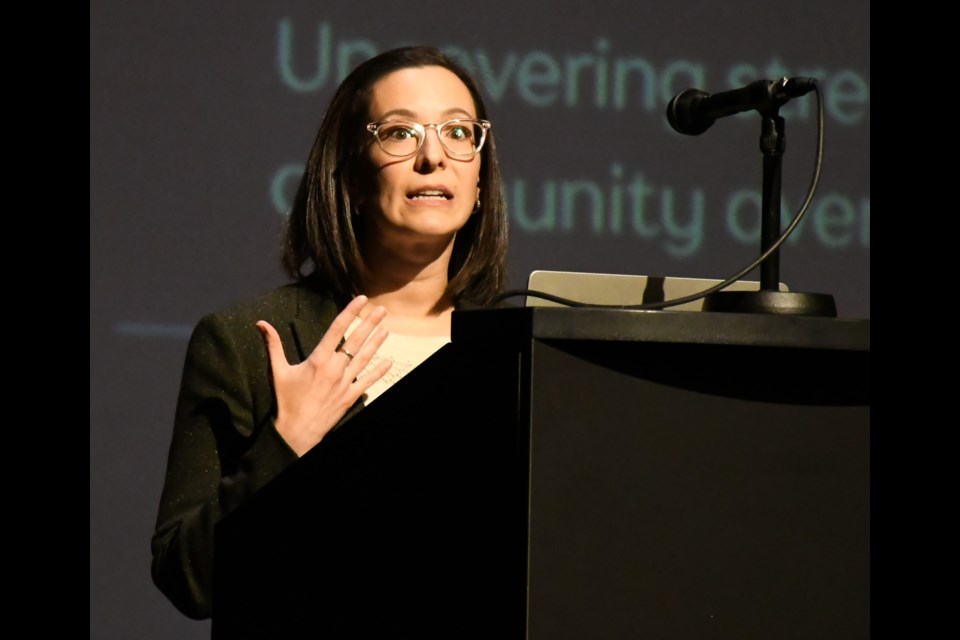Moose Jaw’s demographics will dictate its future, which means the city must better prepare for an aging population while ensuring its younger citizens aren’t forgotten, a sociologist says.
“Population and why it matters” was the title of Dr. Laura Wright’s talk at the Moose Jaw Cultural Centre on April 5, as part of the City of Moose Jaw’s ongoing series to promote the creation of a new Official Community Plan (OCP) and zoning bylaw.
Wright is an associate professor of sociology at the University of Saskatchewan.
“Demography is destiny,” she told the crowd of roughly 30 people at the Mae Wilson Theatre.
Demography — or demographics — studies a population’s size and composition and how it changes over time, Wright explained. It looks at understanding communities’ pasts, presents and futures. It also uncovers a community’s strengths and needs and can guide planning, policy development and decision-making.
The three factors that comprise demography are births, deaths and migration.
Wright showed a chart featuring Moose Jaw’s population from 2001 to 2021, which stayed “pretty stable” during those 20 years. Specifically, The Friendly City grew by 0.5 per cent in 2006, 3.2 per cent in 2011 and 1.8 per cent in 2016, while it shrunk by 0.5 per cent in 2021.
In comparison, during those same years, Saskatchewan’s population shrunk by 1.1 per cent before climbing by 6.7 per cent, 6.3 per cent and 3.1 per cent.
For a “very long time” — but particularly since 2018-19 — deaths in Moose Jaw outpaced births, while there has also been plenty of net out-migration, said Wright. The only thing that kept Moose Jaw’s population stable — including during those 20 years — was international migration.
Sociologists use two metrics to understand demographics: population pyramids and dependency ratio, said Wright.
Population pyramids contain data about every age category in a place, with the youngest at the bottom — or base — and older residents layering on top.
Meanwhile, the dependency ratio is about “who’s relying on whom” to provide the tax base and services. The formula is the youngest (zero to 14) plus the oldest (65 and older) divided by the working population (15 to 64) provides the ratio number.
Wright showed a slide comparing Nigeria and South Korea. The African country has a wide base because of its high fertility and high growth, while the Asian country has a narrow base and bulging middle and top because it has many seniors, low fertility and a shrinking population.
Meanwhile, population pyramids for Canada and Moose Jaw look similar, with baby boomers (born between 1946-66) and millennials (1980-96) the two largest cohorts and Generation X (1965-79), Z (1997 to 2010) and Alpha (2010 to present) the smallest cohorts.
“What we’re seeing in Canada and Moose Jaw is population aging. Essentially, the average age is increasing as there are fewer and fewer births (and) there’s a lower fertility,” Wright said. “Also contributing to population aging is longer life expectancies — which is a good thing.
Young people permanently leaving Moose Jaw makes population aging worse, but to offset that, officials need to increase in-migration and decrease out-migration, she continued. This can attract a core working-age population that can pay taxes and provides services for the youngest and oldest.
An aging and changing population will affect many areas of life, such as schools, health services, the labour market, economic growth, social services, housing supply and family structures, Wright said.
It is possible to mitigate an aging population and promote population growth by creating a plan to meet the community’s needs, she continued.
A community can encourage more births by making child care affordable and accessible, having family-friendly work policies, providing services for young families and removing barriers that prevent families from having more kids.
Deaths can be addressed by promoting healthy aging, ensuring seniors can age in place, providing accessible health-care services, and providing senior-focused services.
With migration, a community can ensure there are jobs for young graduates, support people to remain in Moose Jaw and attract new people from Canada and internationally.
“Across Canada and in most Western countries, migration really is the key to slowing population aging … ,” said Wright.
Saskatchewan’s international immigration is composed of people coming through nominee programs (66.2 per cent), followed by economic reasons (28.7 per cent), with family (10.9 per cent) and refugees (5.8 per cent).
“So population aging and population potential decline has huge ramifications for communities (and) for what communities need (and) look like in the future … ,” Wright added.




